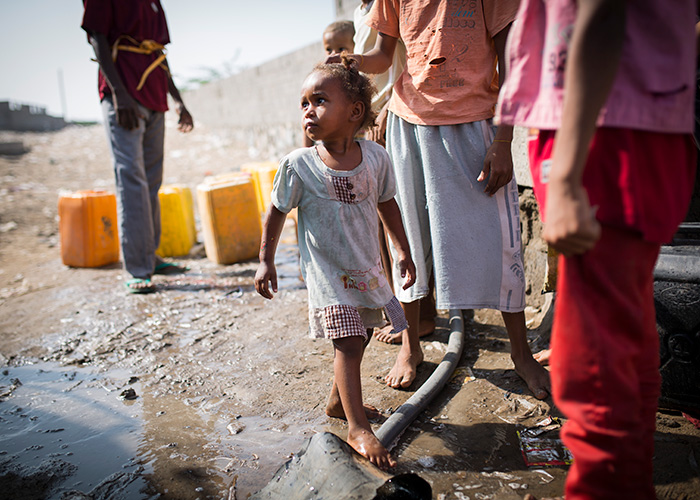A quarter of all civilian casualties across Yemen in 2019 were recorded in Hodeidah governorate. Despite a ceasefire in the port city being at the heart of last year’s Stockholm Agreement, there have been 799 deaths in Hodeidah since the Agreement was signed, the highest toll nationwide.
Families continue to flee for their lives, with nearly 390,000 Yemenis uprooted from their homes so far in 2019. Half of all those displaced came from just three governorates – Hajjah, Hodeidah, and Al Dhale’e.
Despite a drop in the level of violence compared to 2018, Hodeidah, Sa’ada, Taizz, Al Dhale, and Hajjah remain the most dangerous areas for civilians in 2019.
As aid agencies working in Yemen, we are outraged that after almost five years, Yemenis continue to suffer from an incalculable humanitarian crisis fuelled by conflict and civilians continue to bear the brunt of the violence. Houses, farms, markets, and health facilities are damaged and destroyed, worsening an already dire humanitarian situation.
Yemen is the world’s biggest humanitarian crisis. Ten million people face starvation and 7 million are malnourished. Fighting and restrictions put in place by the authorities hamper our organisations’ ability to reach the communities in greatest need. Conflict also continues to block people’s access to markets and services, and to damage essential infrastructure such as hospitals, schools, and water systems.
Last month’s signing of the Riyadh Agreement, as well as a general de-escalation in hostilities, presents a real window of opportunity to end the war. If urgent action is not taken, we could see another five years of conflict, leading to a greater catastrophe for civilians.
We call on all parties to the conflict, the United Nations Security Council, and countries with influence to work together and speed up implementation of the Stockholm Agreement. The recent announcement of the opening of Sana’a airport for medical flights is a positive sign, and if implemented, it will help thousands of sick Yemenis access lifesaving medical care.
Now is the time to build confidence towards peace through the Agreement and beyond, by implementing revenue-sharing from Hodeidah port to pay salaries across the country and by ending the politicised deadlock over fuel to resolve the crisis.
While we call for full implementation of the Stockholm Agreement, it should not be a pre-condition for peace in Yemen. A nationwide ceasefire must also be immediately put in place to secure long-overdue peace talks. What Yemen needs most is an end to the violence through a political solution to the conflict that takes into account the needs of women, youth, and all of civil society.
Signed by:
- Action Against Hunger
- Adventist Relief and Development Agency
- CARE International
- Danish Refugee Council
- Handicap International – Humanity and Inclusion
- Islamic Relief
- International Rescue Committee
- Intersos
- Medecins du Monde
- Norwegian Refugee Council
- Oxfam
- Première Urgence Internationale
- Saferworld
- Vision Hope International
- ZOA
Latest casualty (deaths and injuries) and humanitarian figures:
- A total of 1,008 civilians have been killed by armed violence so far this year, down from 2,049 for all of last year.
- More civilians have been killed or injured by ground fighting this year than in the 12 months before.
- More than 2,100 incidents of armed violence have involved civilians since the Stockholm Agreement – no improvement on the prior 12 months.
- The number of civilians were killed or injured by explosive ordnance has increased, from 349 people impacted last year to 504 so far this year.
- 327 incidents of armed violence directly affected civilian houses in 2019, 60 percent of the total incidents. Half of the child and women casualties in 2019 resulted from incidents affecting houses.
- More than 40 percent of all incidents of armed violence affecting civilians occurred in Hodeidah Governorate. A quarter of all 3,086 country-wide civilian casualties took place in Hodeidah, followed by Taiz Governorate.
- The overall number of civilian casualties dropped compared with 2018, largely due to a significant reduction in airstrikes in Hodeidah and a recent de-escalation of violence across the country.
- Data and analysis on civilian casualties and impact on civilian infrastructure was conducted by ACAPS and CIMP. This is open source data and has not been separately verified by the INGOs that are signatories here.
Photos, videos and stories of displaced people:
- Photos of people displaced from Hodeidah can be found here.
- Stories about a displaced family can be found here.
- Video of a displaced family can be found here.
For media interviews, please contact:
- Jovita Sandaite, Action Against Hunger, Advocacy Expert, [email protected], +962 778 527 171
- Michelle Delaney, Norwegian Refugee Council Media Advisor, [email protected], +47 941 65 579
- Alex Hilliard, CARE Yemen Policy, Communications and Information Coordinator, [email protected], +447951727473
- Sarah Grainger, Oxfam Senior Press Officer, [email protected], +44 781 018 1514.
Notes to editors
- Action Against Hunger is a global humanitarian organisation that takes decisive action against the causes and effects of hunger. We save the lives of malnourished children and work with their communities before and after disaster strikes. We ensure that everyone can access clean water, food, training and healthcare. We enable people to provide for themselves and we constantly search for more effective solutions, while sharing our knowledge and expertise with the world. We push for long-term change. We will never give up. Until the world is free from hunger.
- In 2018, Action Against Hunger helped more than 21 million people in nearly 50 countries around the world.


